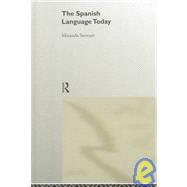
Note: Supplemental materials are not guaranteed with Rental or Used book purchases.
Purchase Benefits
What is included with this book?
| Preface | xi | (4) | |||
| Acknowledgements | xv | ||||
| PART I Spanish as a world language | 1 | (40) | |||
|
3 | (11) | |||
|
3 | (1) | |||
|
3 | (7) | |||
|
3 | (2) | |||
|
5 | (1) | |||
|
6 | (1) | |||
|
7 | (3) | |||
|
10 | (3) | |||
|
10 | (1) | |||
|
11 | (1) | |||
|
12 | (1) | |||
|
13 | (1) | |||
|
14 | (27) | |||
|
16 | (20) | |||
|
16 | (5) | |||
|
21 | (7) | |||
|
28 | (3) | |||
|
31 | (4) | |||
|
35 | (1) | |||
|
36 | (3) | |||
|
39 | (2) | |||
| PART II Spanish: variation and change | 41 | (78) | |||
|
43 | (18) | |||
|
44 | (1) | |||
|
45 | (9) | |||
|
54 | (7) | |||
|
61 | (35) | |||
|
61 | (27) | |||
|
62 | (20) | |||
|
82 | (6) | |||
|
88 | (7) | |||
|
89 | (1) | |||
|
90 | (5) | |||
|
95 | (1) | |||
|
96 | (23) | |||
|
96 | (15) | |||
|
97 | (1) | |||
|
97 | (1) | |||
|
98 | (1) | |||
|
99 | (1) | |||
|
99 | (2) | |||
|
101 | (4) | |||
|
105 | (6) | |||
|
111 | (2) | |||
|
111 | (1) | |||
|
112 | (1) | |||
|
113 | (4) | |||
|
113 | (1) | |||
|
114 | (1) | |||
|
115 | (1) | |||
|
115 | (2) | |||
|
117 | (2) | |||
| PART III The Spanish language in use | 119 | (60) | |||
|
121 | (14) | |||
|
122 | (4) | |||
|
122 | (1) | |||
|
122 | (4) | |||
|
126 | (3) | |||
|
129 | (3) | |||
|
132 | (2) | |||
|
134 | (1) | |||
|
135 | (26) | |||
|
135 | (5) | |||
|
140 | (4) | |||
|
144 | (6) | |||
|
150 | (5) | |||
|
155 | (5) | |||
|
160 | (1) | |||
|
161 | (18) | |||
|
161 | (3) | |||
|
164 | (5) | |||
|
165 | (1) | |||
|
165 | (1) | |||
|
166 | (1) | |||
|
167 | (1) | |||
|
167 | (1) | |||
|
168 | (1) | |||
|
169 | (8) | |||
|
171 | (5) | |||
|
176 | (1) | |||
|
177 | (2) | |||
| PART IV Spanish in contact | 179 | (20) | |||
|
181 | (18) | |||
|
182 | (3) | |||
|
183 | (2) | |||
|
185 | (8) | |||
|
185 | (1) | |||
|
186 | (1) | |||
|
187 | (1) | |||
|
188 | (2) | |||
|
190 | (3) | |||
|
193 | (4) | |||
|
197 | (2) | |||
| Conclusion | 199 | (2) | |||
| Notes | 201 | (13) | |||
| Glossary | 214 | (6) | |||
| Selected bibliography and further reading | 220 | (9) | |||
| Other sources | 228 | (1) | |||
| Index | 229 |
The New copy of this book will include any supplemental materials advertised. Please check the title of the book to determine if it should include any access cards, study guides, lab manuals, CDs, etc.
The Used, Rental and eBook copies of this book are not guaranteed to include any supplemental materials. Typically, only the book itself is included. This is true even if the title states it includes any access cards, study guides, lab manuals, CDs, etc.